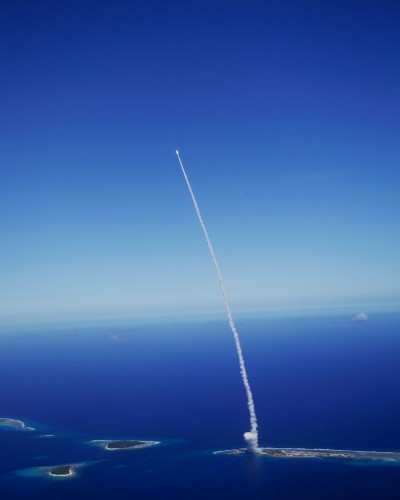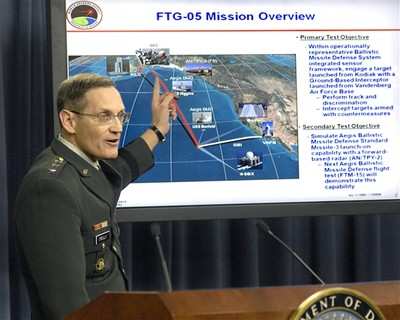Interceptor Strikes Target... But There Was A Glitch
The US military scored a badly-needed victory Friday in its
quest to implement a full-scale ballistic missile defense shield.
The Missile Defense Agency shot down a mock enemy missile,
employing a synchronized network of sensors in what officials
called the largest and most complex test of the missile defense
system to date.

A mock target missile was fired from Kodiak, AK at 3:04 pm EST.
About 30 minutes later, an interceptor missile was fired from a
silo at California's Vandenberg Air Force Base, CA, under the
direction of soldiers based at Fort Greely, AK.
The two successfully collided off the coast of California
minutes later... marking the first time the agency has been able to
synchronize its network of varied sensor types and frequencies to
successfully track, report and intercept a single target, the
agency's top officer said.
"Overall, I'm extremely pleased, because ... the core of our
missile defense system is the fact that we can operate in layers
and have multiple systems working together," Army Lt. Gen. Patrick
J. O'Reilly said. "The key to our protection and the effectiveness
of the systems is to have all of these different sensors
simultaneously tracking, and the system [knowing] exactly that it's
not multiple objects, it's one object up there."
If the multiple radars did not work together, each would have
reported a different target to the system.
The test combined an early warning radar system south of
Sacramento, CA; a temporary mobile radar system posted in Juneau,
AK; two AEGIS ballistic missile defense ships off the Pacific
coast; and, a sea-based radar system.
The test also marked the first time soldiers from the 49th
Missile Defense Battalion based at Fort Greely were in control of
the launch. On previous tests, a Colorado Springs-based unit was
used.
Each of the systems was networked together, despite their varied
sizes and frequencies, to form an accurate, single-target track,
O'Reilly said.
 Soldiers, airmen and sailors
operated all parts of the system, and the USS Benfold, a Navy
guided-missile destroyer equipped with the AEGIS air-defense
system, went through all of the motions of a simulated intercept
successfully, O'Reilly said.
Soldiers, airmen and sailors
operated all parts of the system, and the USS Benfold, a Navy
guided-missile destroyer equipped with the AEGIS air-defense
system, went through all of the motions of a simulated intercept
successfully, O'Reilly said.
"What we showed today is all those sensors working together," he
said. "At any one time, the system knew which sensor was reporting
... and tracking it and it gave the warfighter a presentation of
the target. It is the first time we have ever done that in an
actual test and with our soldiers [and sailors and airmen]
operating it."
Not everything went to plan, though. Officials had hoped to
deploy countermeasures -- like chaff, decoys or replicas -- during
the flight that would test the system's reaction to multiple
objects. That didn't happen.
"Countermeasures are very difficult to deploy," O'Reilly (shown
below) said. "We have had trouble deploying them in the past."
Officials noted even though the countermeasures didn't deploy,
the upper stage of the mock enemy missile was still in the area...
giving the interceptor a test to determine which of the two objects
to hit, based on sensor data.

Pentagon officials said this test was "very realistic" and
followed a trajectory and mimicked a launch similar to one the U.S.
military believes could be a threat.
The test cost $120 million to $150 million. Thirteen similar
tests have been conducted since 1999, seven successfully hitting
their targets. The last previous test, in September 2007, was
successful.
(Aero-News thanks Fred W. Baker III, American Forces Press
Service)
 ANN's Daily Aero-Linx (08.27.25)
ANN's Daily Aero-Linx (08.27.25) ANN's Daily Aero-Term (08.27.25): Class C Service
ANN's Daily Aero-Term (08.27.25): Class C Service ANN FAQ: Submit a News Story!
ANN FAQ: Submit a News Story! Airborne-NextGen 08.26.25: Iran UAV Knockoffs, X-37B Spaceplane, Army Training
Airborne-NextGen 08.26.25: Iran UAV Knockoffs, X-37B Spaceplane, Army Training Classic Klyde Morris (08.25.25)
Classic Klyde Morris (08.25.25)





